Homelessness: Causes and Solutions
VerifiedAdded on 2020/05/28
|9
|1708
|108
AI Summary
This assignment delves into the multifaceted issue of homelessness, investigating its underlying causes and exploring potential solutions. Students are tasked with analyzing the complexities of homelessness, considering factors such as poverty, mental health, and lack of affordable housing. The assignment encourages critical evaluation of existing policies and programs aimed at addressing homelessness, assessing their effectiveness and identifying areas for improvement.
Contribute Materials
Your contribution can guide someone’s learning journey. Share your
documents today.
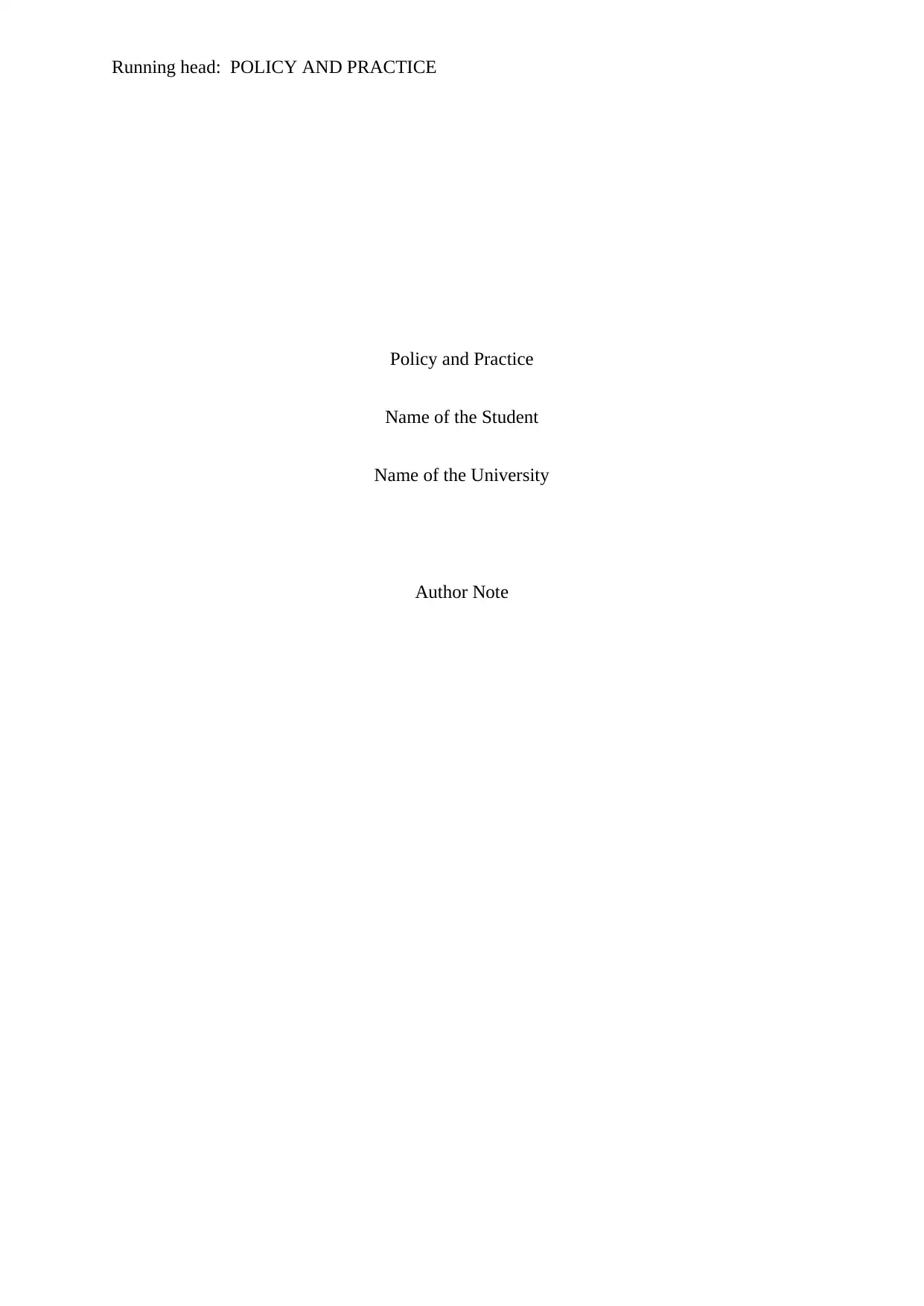
Running head: POLICY AND PRACTICE
Policy and Practice
Name of the Student
Name of the University
Author Note
Policy and Practice
Name of the Student
Name of the University
Author Note
Secure Best Marks with AI Grader
Need help grading? Try our AI Grader for instant feedback on your assignments.
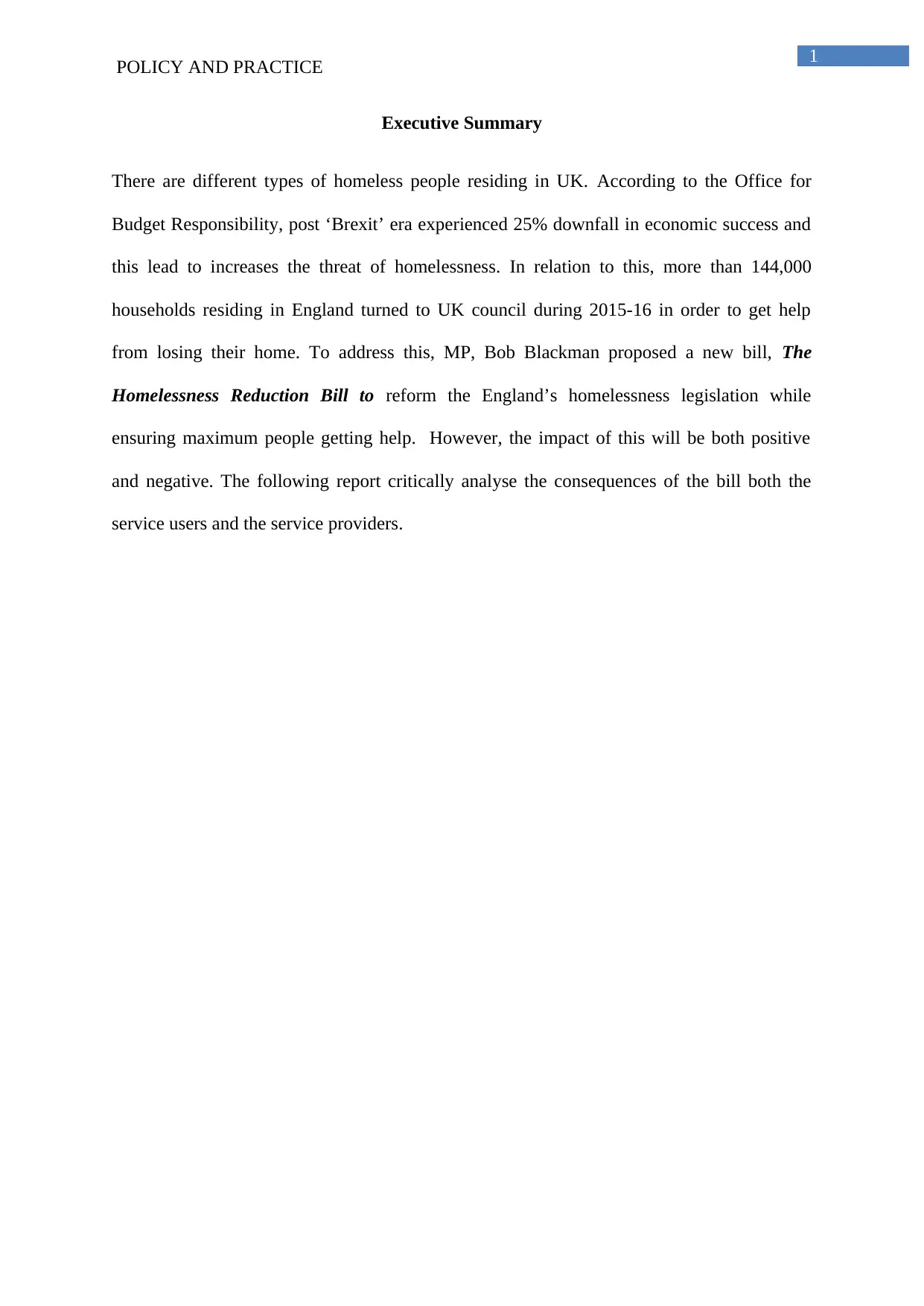
1
POLICY AND PRACTICE
Executive Summary
There are different types of homeless people residing in UK. According to the Office for
Budget Responsibility, post ‘Brexit’ era experienced 25% downfall in economic success and
this lead to increases the threat of homelessness. In relation to this, more than 144,000
households residing in England turned to UK council during 2015-16 in order to get help
from losing their home. To address this, MP, Bob Blackman proposed a new bill, The
Homelessness Reduction Bill to reform the England’s homelessness legislation while
ensuring maximum people getting help. However, the impact of this will be both positive
and negative. The following report critically analyse the consequences of the bill both the
service users and the service providers.
POLICY AND PRACTICE
Executive Summary
There are different types of homeless people residing in UK. According to the Office for
Budget Responsibility, post ‘Brexit’ era experienced 25% downfall in economic success and
this lead to increases the threat of homelessness. In relation to this, more than 144,000
households residing in England turned to UK council during 2015-16 in order to get help
from losing their home. To address this, MP, Bob Blackman proposed a new bill, The
Homelessness Reduction Bill to reform the England’s homelessness legislation while
ensuring maximum people getting help. However, the impact of this will be both positive
and negative. The following report critically analyse the consequences of the bill both the
service users and the service providers.
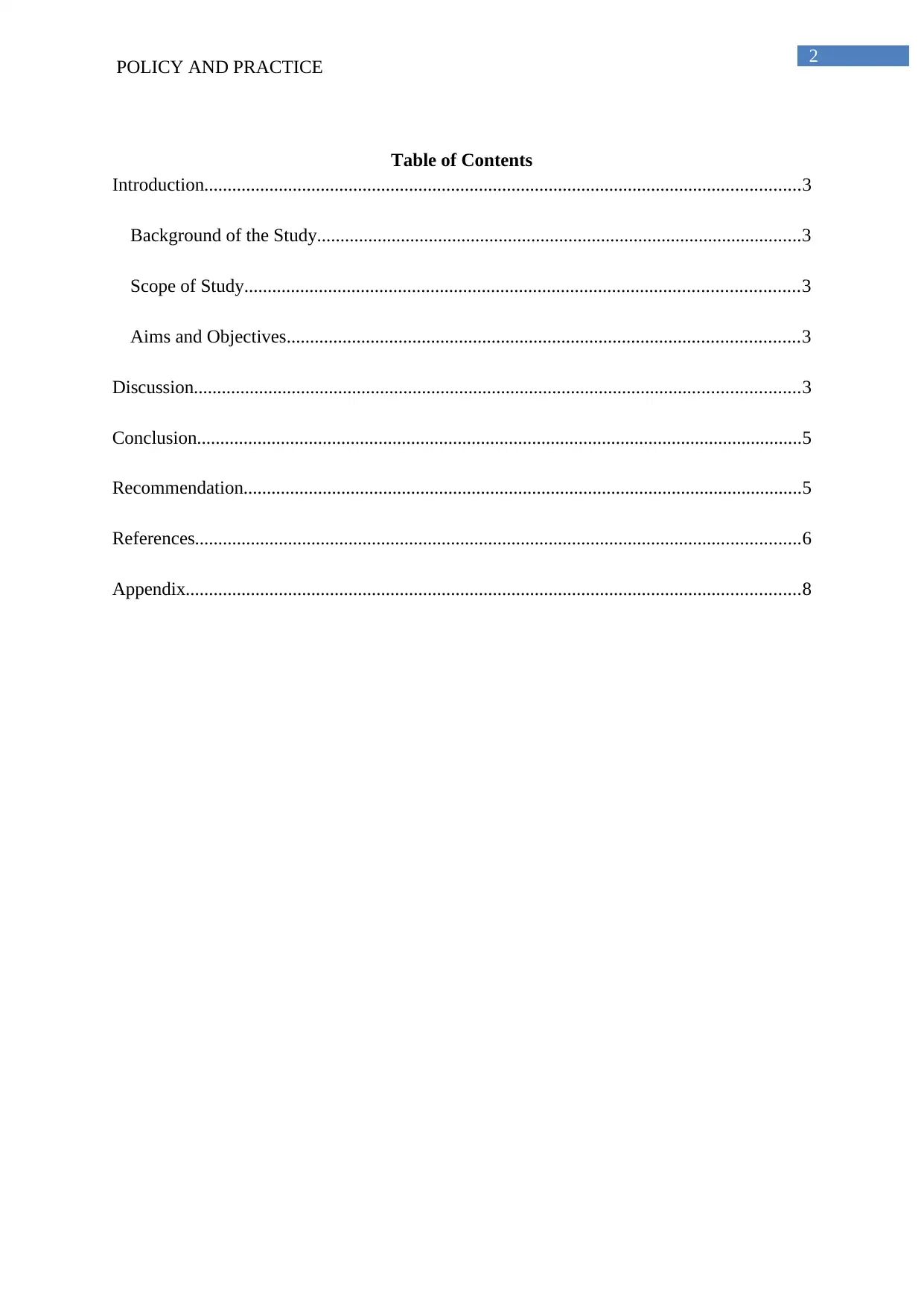
2
POLICY AND PRACTICE
Table of Contents
Introduction................................................................................................................................3
Background of the Study........................................................................................................3
Scope of Study.......................................................................................................................3
Aims and Objectives..............................................................................................................3
Discussion..................................................................................................................................3
Conclusion..................................................................................................................................5
Recommendation........................................................................................................................5
References..................................................................................................................................6
Appendix....................................................................................................................................8
POLICY AND PRACTICE
Table of Contents
Introduction................................................................................................................................3
Background of the Study........................................................................................................3
Scope of Study.......................................................................................................................3
Aims and Objectives..............................................................................................................3
Discussion..................................................................................................................................3
Conclusion..................................................................................................................................5
Recommendation........................................................................................................................5
References..................................................................................................................................6
Appendix....................................................................................................................................8
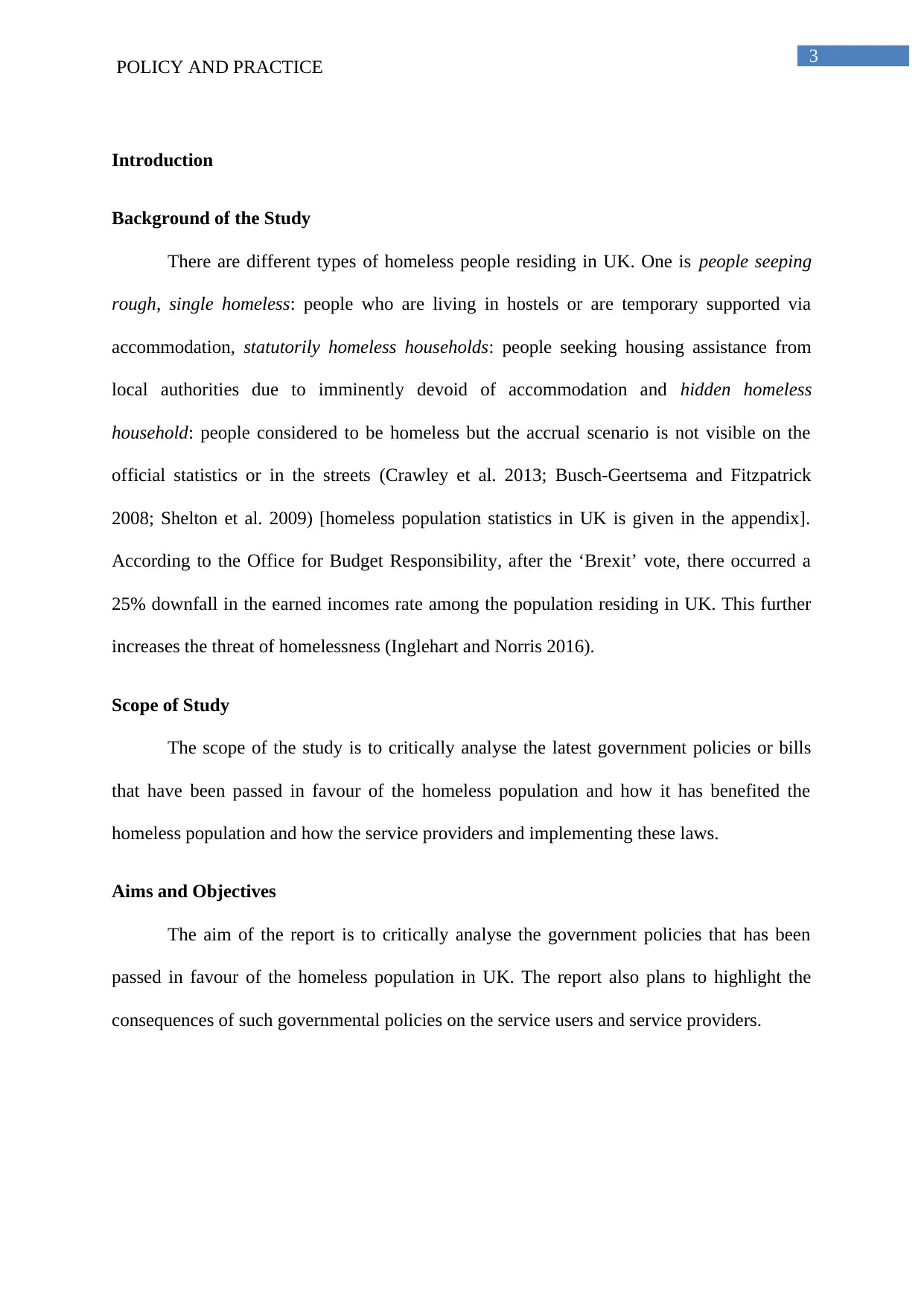
3
POLICY AND PRACTICE
Introduction
Background of the Study
There are different types of homeless people residing in UK. One is people seeping
rough, single homeless: people who are living in hostels or are temporary supported via
accommodation, statutorily homeless households: people seeking housing assistance from
local authorities due to imminently devoid of accommodation and hidden homeless
household: people considered to be homeless but the accrual scenario is not visible on the
official statistics or in the streets (Crawley et al. 2013; Busch-Geertsema and Fitzpatrick
2008; Shelton et al. 2009) [homeless population statistics in UK is given in the appendix].
According to the Office for Budget Responsibility, after the ‘Brexit’ vote, there occurred a
25% downfall in the earned incomes rate among the population residing in UK. This further
increases the threat of homelessness (Inglehart and Norris 2016).
Scope of Study
The scope of the study is to critically analyse the latest government policies or bills
that have been passed in favour of the homeless population and how it has benefited the
homeless population and how the service providers and implementing these laws.
Aims and Objectives
The aim of the report is to critically analyse the government policies that has been
passed in favour of the homeless population in UK. The report also plans to highlight the
consequences of such governmental policies on the service users and service providers.
POLICY AND PRACTICE
Introduction
Background of the Study
There are different types of homeless people residing in UK. One is people seeping
rough, single homeless: people who are living in hostels or are temporary supported via
accommodation, statutorily homeless households: people seeking housing assistance from
local authorities due to imminently devoid of accommodation and hidden homeless
household: people considered to be homeless but the accrual scenario is not visible on the
official statistics or in the streets (Crawley et al. 2013; Busch-Geertsema and Fitzpatrick
2008; Shelton et al. 2009) [homeless population statistics in UK is given in the appendix].
According to the Office for Budget Responsibility, after the ‘Brexit’ vote, there occurred a
25% downfall in the earned incomes rate among the population residing in UK. This further
increases the threat of homelessness (Inglehart and Norris 2016).
Scope of Study
The scope of the study is to critically analyse the latest government policies or bills
that have been passed in favour of the homeless population and how it has benefited the
homeless population and how the service providers and implementing these laws.
Aims and Objectives
The aim of the report is to critically analyse the government policies that has been
passed in favour of the homeless population in UK. The report also plans to highlight the
consequences of such governmental policies on the service users and service providers.
Secure Best Marks with AI Grader
Need help grading? Try our AI Grader for instant feedback on your assignments.
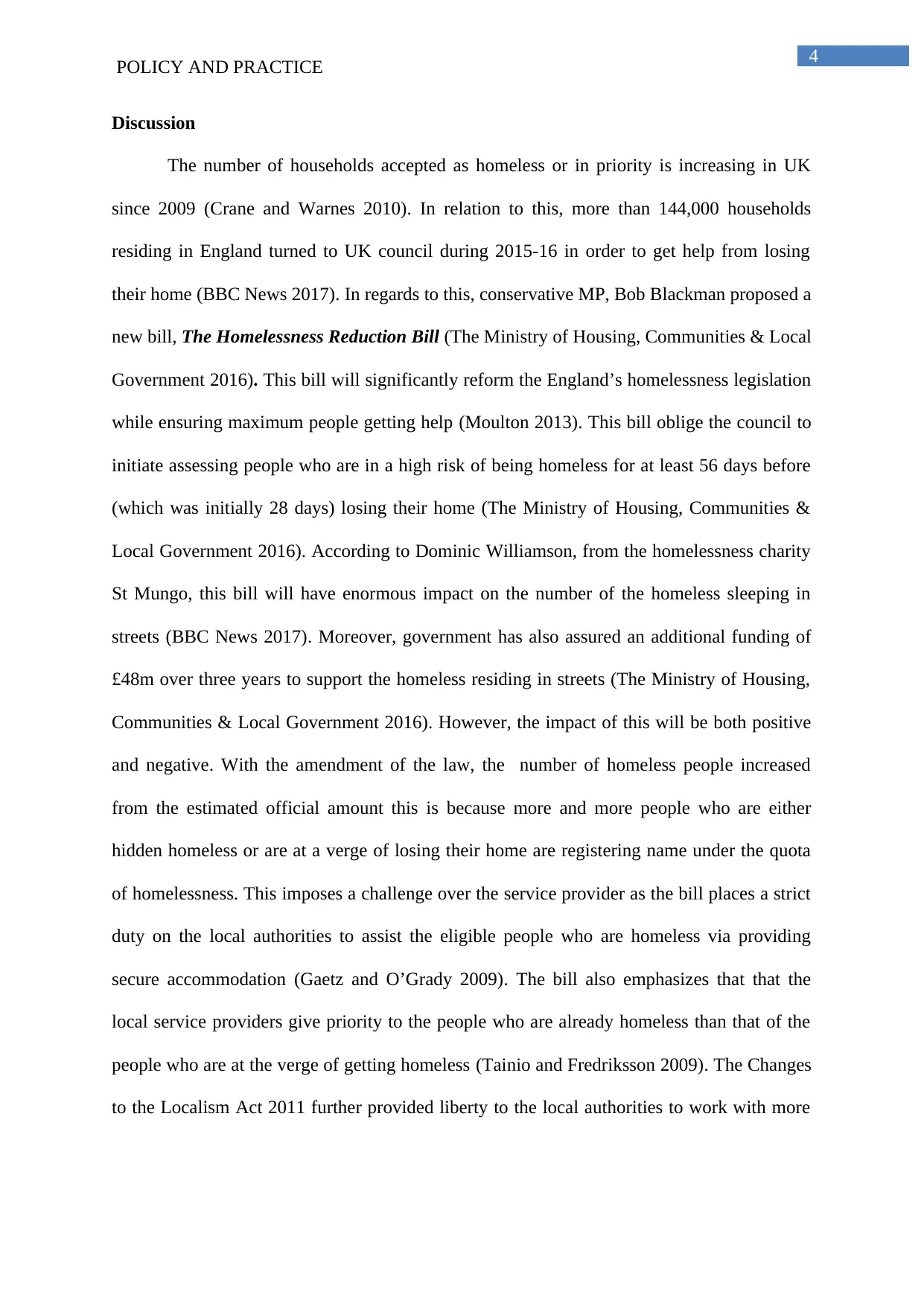
4
POLICY AND PRACTICE
Discussion
The number of households accepted as homeless or in priority is increasing in UK
since 2009 (Crane and Warnes 2010). In relation to this, more than 144,000 households
residing in England turned to UK council during 2015-16 in order to get help from losing
their home (BBC News 2017). In regards to this, conservative MP, Bob Blackman proposed a
new bill, The Homelessness Reduction Bill (The Ministry of Housing, Communities & Local
Government 2016). This bill will significantly reform the England’s homelessness legislation
while ensuring maximum people getting help (Moulton 2013). This bill oblige the council to
initiate assessing people who are in a high risk of being homeless for at least 56 days before
(which was initially 28 days) losing their home (The Ministry of Housing, Communities &
Local Government 2016). According to Dominic Williamson, from the homelessness charity
St Mungo, this bill will have enormous impact on the number of the homeless sleeping in
streets (BBC News 2017). Moreover, government has also assured an additional funding of
£48m over three years to support the homeless residing in streets (The Ministry of Housing,
Communities & Local Government 2016). However, the impact of this will be both positive
and negative. With the amendment of the law, the number of homeless people increased
from the estimated official amount this is because more and more people who are either
hidden homeless or are at a verge of losing their home are registering name under the quota
of homelessness. This imposes a challenge over the service provider as the bill places a strict
duty on the local authorities to assist the eligible people who are homeless via providing
secure accommodation (Gaetz and O’Grady 2009). The bill also emphasizes that that the
local service providers give priority to the people who are already homeless than that of the
people who are at the verge of getting homeless (Tainio and Fredriksson 2009). The Changes
to the Localism Act 2011 further provided liberty to the local authorities to work with more
POLICY AND PRACTICE
Discussion
The number of households accepted as homeless or in priority is increasing in UK
since 2009 (Crane and Warnes 2010). In relation to this, more than 144,000 households
residing in England turned to UK council during 2015-16 in order to get help from losing
their home (BBC News 2017). In regards to this, conservative MP, Bob Blackman proposed a
new bill, The Homelessness Reduction Bill (The Ministry of Housing, Communities & Local
Government 2016). This bill will significantly reform the England’s homelessness legislation
while ensuring maximum people getting help (Moulton 2013). This bill oblige the council to
initiate assessing people who are in a high risk of being homeless for at least 56 days before
(which was initially 28 days) losing their home (The Ministry of Housing, Communities &
Local Government 2016). According to Dominic Williamson, from the homelessness charity
St Mungo, this bill will have enormous impact on the number of the homeless sleeping in
streets (BBC News 2017). Moreover, government has also assured an additional funding of
£48m over three years to support the homeless residing in streets (The Ministry of Housing,
Communities & Local Government 2016). However, the impact of this will be both positive
and negative. With the amendment of the law, the number of homeless people increased
from the estimated official amount this is because more and more people who are either
hidden homeless or are at a verge of losing their home are registering name under the quota
of homelessness. This imposes a challenge over the service provider as the bill places a strict
duty on the local authorities to assist the eligible people who are homeless via providing
secure accommodation (Gaetz and O’Grady 2009). The bill also emphasizes that that the
local service providers give priority to the people who are already homeless than that of the
people who are at the verge of getting homeless (Tainio and Fredriksson 2009). The Changes
to the Localism Act 2011 further provided liberty to the local authorities to work with more
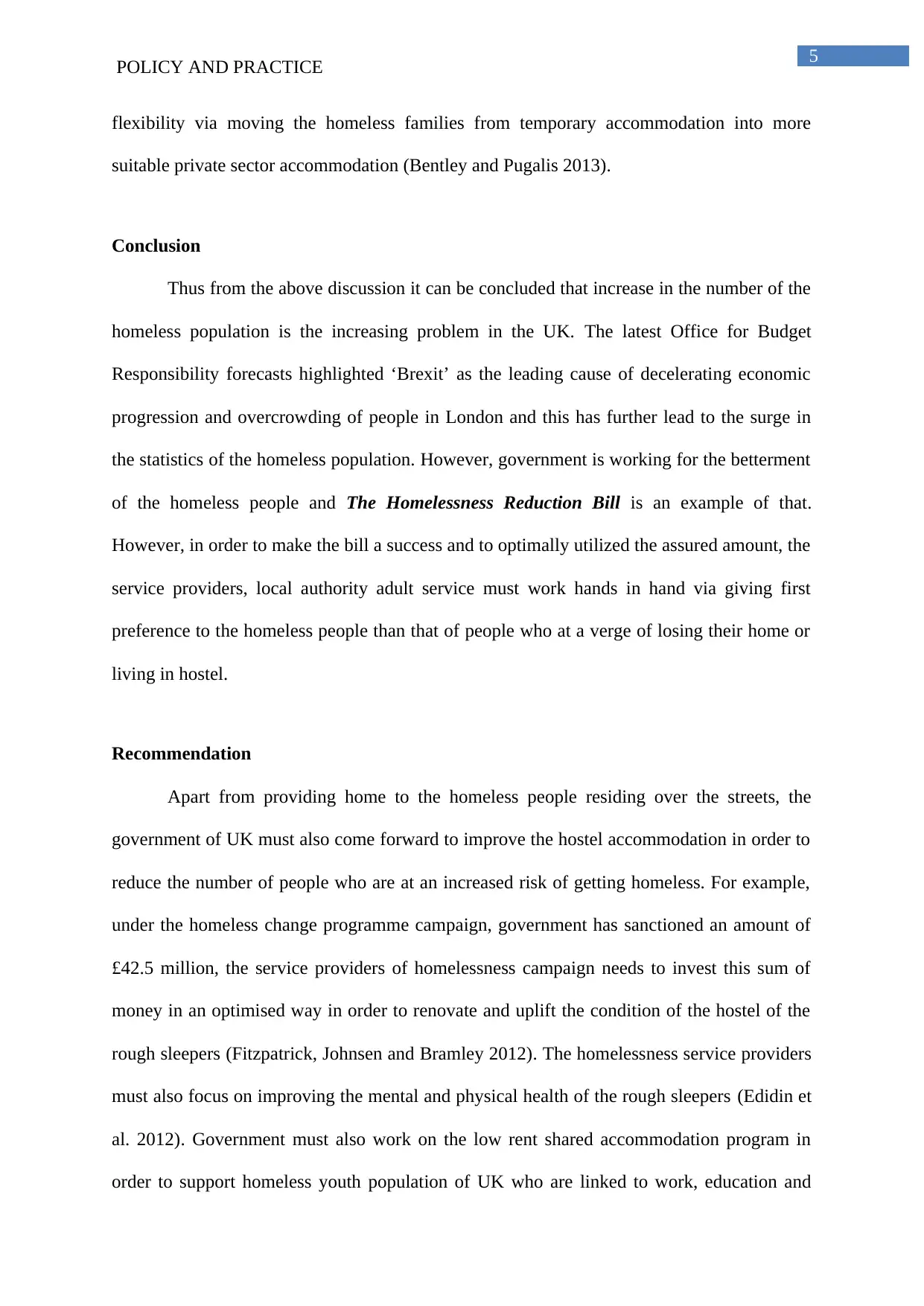
5
POLICY AND PRACTICE
flexibility via moving the homeless families from temporary accommodation into more
suitable private sector accommodation (Bentley and Pugalis 2013).
Conclusion
Thus from the above discussion it can be concluded that increase in the number of the
homeless population is the increasing problem in the UK. The latest Office for Budget
Responsibility forecasts highlighted ‘Brexit’ as the leading cause of decelerating economic
progression and overcrowding of people in London and this has further lead to the surge in
the statistics of the homeless population. However, government is working for the betterment
of the homeless people and The Homelessness Reduction Bill is an example of that.
However, in order to make the bill a success and to optimally utilized the assured amount, the
service providers, local authority adult service must work hands in hand via giving first
preference to the homeless people than that of people who at a verge of losing their home or
living in hostel.
Recommendation
Apart from providing home to the homeless people residing over the streets, the
government of UK must also come forward to improve the hostel accommodation in order to
reduce the number of people who are at an increased risk of getting homeless. For example,
under the homeless change programme campaign, government has sanctioned an amount of
£42.5 million, the service providers of homelessness campaign needs to invest this sum of
money in an optimised way in order to renovate and uplift the condition of the hostel of the
rough sleepers (Fitzpatrick, Johnsen and Bramley 2012). The homelessness service providers
must also focus on improving the mental and physical health of the rough sleepers (Edidin et
al. 2012). Government must also work on the low rent shared accommodation program in
order to support homeless youth population of UK who are linked to work, education and
POLICY AND PRACTICE
flexibility via moving the homeless families from temporary accommodation into more
suitable private sector accommodation (Bentley and Pugalis 2013).
Conclusion
Thus from the above discussion it can be concluded that increase in the number of the
homeless population is the increasing problem in the UK. The latest Office for Budget
Responsibility forecasts highlighted ‘Brexit’ as the leading cause of decelerating economic
progression and overcrowding of people in London and this has further lead to the surge in
the statistics of the homeless population. However, government is working for the betterment
of the homeless people and The Homelessness Reduction Bill is an example of that.
However, in order to make the bill a success and to optimally utilized the assured amount, the
service providers, local authority adult service must work hands in hand via giving first
preference to the homeless people than that of people who at a verge of losing their home or
living in hostel.
Recommendation
Apart from providing home to the homeless people residing over the streets, the
government of UK must also come forward to improve the hostel accommodation in order to
reduce the number of people who are at an increased risk of getting homeless. For example,
under the homeless change programme campaign, government has sanctioned an amount of
£42.5 million, the service providers of homelessness campaign needs to invest this sum of
money in an optimised way in order to renovate and uplift the condition of the hostel of the
rough sleepers (Fitzpatrick, Johnsen and Bramley 2012). The homelessness service providers
must also focus on improving the mental and physical health of the rough sleepers (Edidin et
al. 2012). Government must also work on the low rent shared accommodation program in
order to support homeless youth population of UK who are linked to work, education and
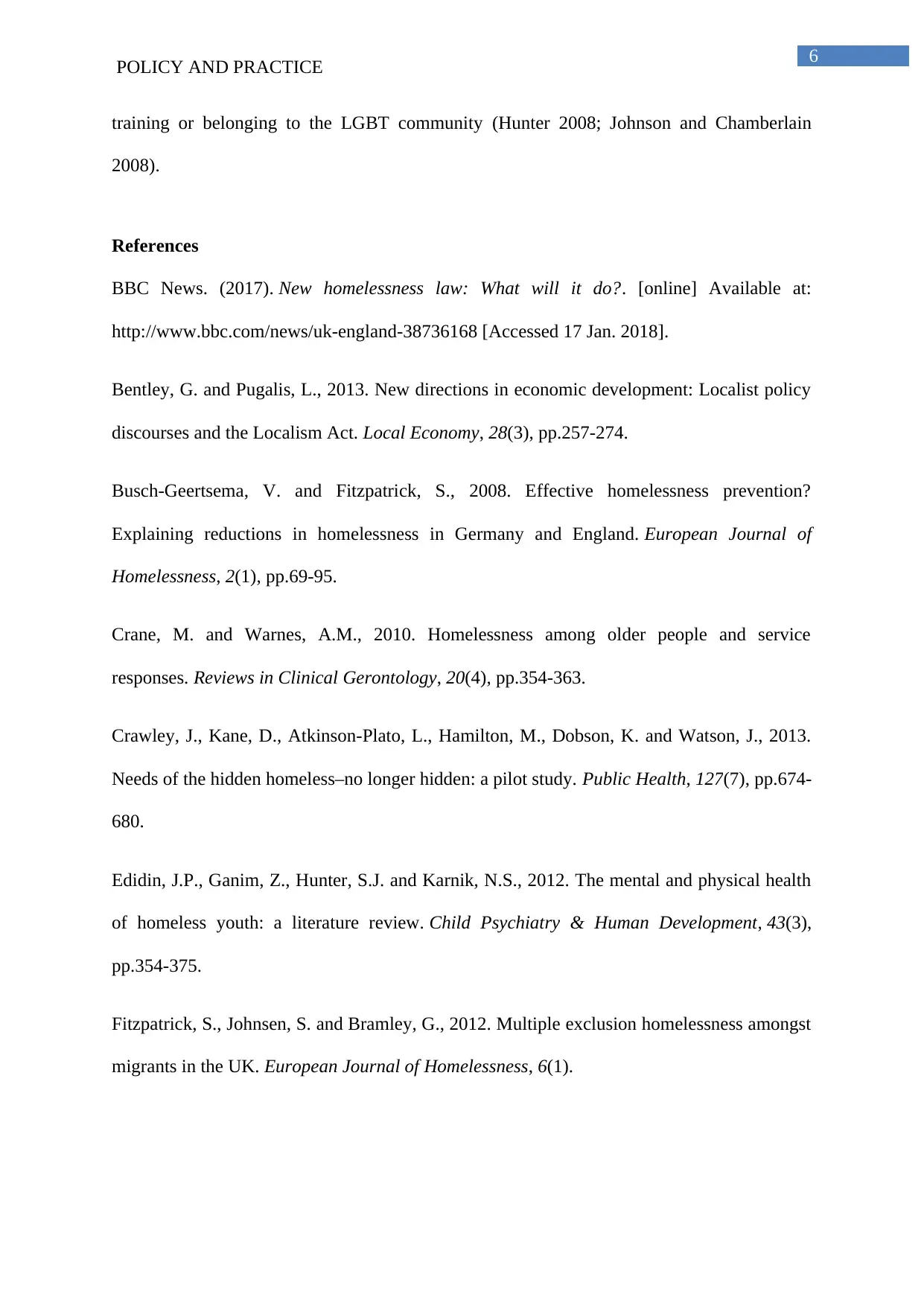
6
POLICY AND PRACTICE
training or belonging to the LGBT community (Hunter 2008; Johnson and Chamberlain
2008).
References
BBC News. (2017). New homelessness law: What will it do?. [online] Available at:
http://www.bbc.com/news/uk-england-38736168 [Accessed 17 Jan. 2018].
Bentley, G. and Pugalis, L., 2013. New directions in economic development: Localist policy
discourses and the Localism Act. Local Economy, 28(3), pp.257-274.
Busch-Geertsema, V. and Fitzpatrick, S., 2008. Effective homelessness prevention?
Explaining reductions in homelessness in Germany and England. European Journal of
Homelessness, 2(1), pp.69-95.
Crane, M. and Warnes, A.M., 2010. Homelessness among older people and service
responses. Reviews in Clinical Gerontology, 20(4), pp.354-363.
Crawley, J., Kane, D., Atkinson-Plato, L., Hamilton, M., Dobson, K. and Watson, J., 2013.
Needs of the hidden homeless–no longer hidden: a pilot study. Public Health, 127(7), pp.674-
680.
Edidin, J.P., Ganim, Z., Hunter, S.J. and Karnik, N.S., 2012. The mental and physical health
of homeless youth: a literature review. Child Psychiatry & Human Development, 43(3),
pp.354-375.
Fitzpatrick, S., Johnsen, S. and Bramley, G., 2012. Multiple exclusion homelessness amongst
migrants in the UK. European Journal of Homelessness, 6(1).
POLICY AND PRACTICE
training or belonging to the LGBT community (Hunter 2008; Johnson and Chamberlain
2008).
References
BBC News. (2017). New homelessness law: What will it do?. [online] Available at:
http://www.bbc.com/news/uk-england-38736168 [Accessed 17 Jan. 2018].
Bentley, G. and Pugalis, L., 2013. New directions in economic development: Localist policy
discourses and the Localism Act. Local Economy, 28(3), pp.257-274.
Busch-Geertsema, V. and Fitzpatrick, S., 2008. Effective homelessness prevention?
Explaining reductions in homelessness in Germany and England. European Journal of
Homelessness, 2(1), pp.69-95.
Crane, M. and Warnes, A.M., 2010. Homelessness among older people and service
responses. Reviews in Clinical Gerontology, 20(4), pp.354-363.
Crawley, J., Kane, D., Atkinson-Plato, L., Hamilton, M., Dobson, K. and Watson, J., 2013.
Needs of the hidden homeless–no longer hidden: a pilot study. Public Health, 127(7), pp.674-
680.
Edidin, J.P., Ganim, Z., Hunter, S.J. and Karnik, N.S., 2012. The mental and physical health
of homeless youth: a literature review. Child Psychiatry & Human Development, 43(3),
pp.354-375.
Fitzpatrick, S., Johnsen, S. and Bramley, G., 2012. Multiple exclusion homelessness amongst
migrants in the UK. European Journal of Homelessness, 6(1).
Paraphrase This Document
Need a fresh take? Get an instant paraphrase of this document with our AI Paraphraser
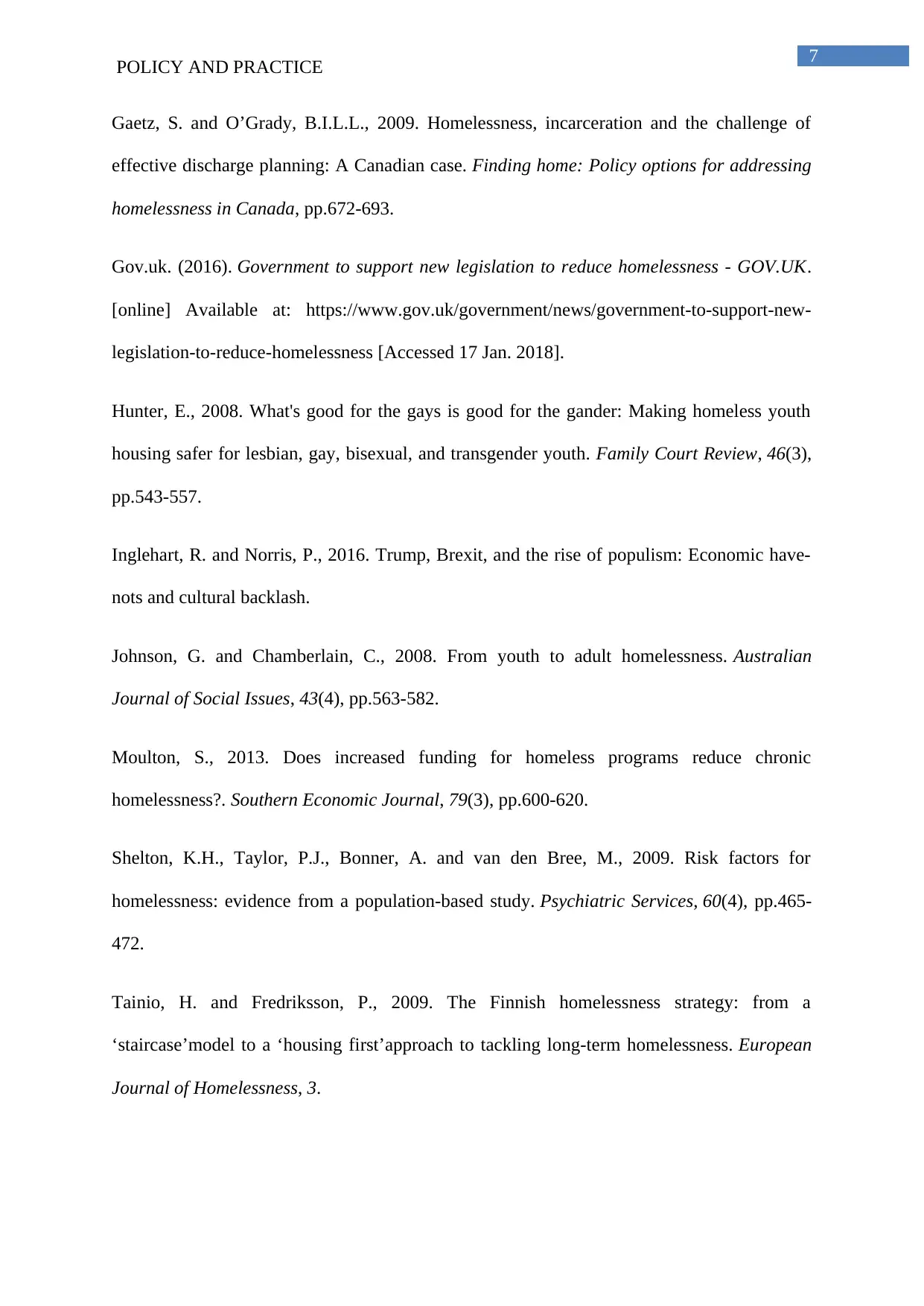
7
POLICY AND PRACTICE
Gaetz, S. and O’Grady, B.I.L.L., 2009. Homelessness, incarceration and the challenge of
effective discharge planning: A Canadian case. Finding home: Policy options for addressing
homelessness in Canada, pp.672-693.
Gov.uk. (2016). Government to support new legislation to reduce homelessness - GOV.UK.
[online] Available at: https://www.gov.uk/government/news/government-to-support-new-
legislation-to-reduce-homelessness [Accessed 17 Jan. 2018].
Hunter, E., 2008. What's good for the gays is good for the gander: Making homeless youth
housing safer for lesbian, gay, bisexual, and transgender youth. Family Court Review, 46(3),
pp.543-557.
Inglehart, R. and Norris, P., 2016. Trump, Brexit, and the rise of populism: Economic have-
nots and cultural backlash.
Johnson, G. and Chamberlain, C., 2008. From youth to adult homelessness. Australian
Journal of Social Issues, 43(4), pp.563-582.
Moulton, S., 2013. Does increased funding for homeless programs reduce chronic
homelessness?. Southern Economic Journal, 79(3), pp.600-620.
Shelton, K.H., Taylor, P.J., Bonner, A. and van den Bree, M., 2009. Risk factors for
homelessness: evidence from a population-based study. Psychiatric Services, 60(4), pp.465-
472.
Tainio, H. and Fredriksson, P., 2009. The Finnish homelessness strategy: from a
‘staircase’model to a ‘housing first’approach to tackling long-term homelessness. European
Journal of Homelessness, 3.
POLICY AND PRACTICE
Gaetz, S. and O’Grady, B.I.L.L., 2009. Homelessness, incarceration and the challenge of
effective discharge planning: A Canadian case. Finding home: Policy options for addressing
homelessness in Canada, pp.672-693.
Gov.uk. (2016). Government to support new legislation to reduce homelessness - GOV.UK.
[online] Available at: https://www.gov.uk/government/news/government-to-support-new-
legislation-to-reduce-homelessness [Accessed 17 Jan. 2018].
Hunter, E., 2008. What's good for the gays is good for the gander: Making homeless youth
housing safer for lesbian, gay, bisexual, and transgender youth. Family Court Review, 46(3),
pp.543-557.
Inglehart, R. and Norris, P., 2016. Trump, Brexit, and the rise of populism: Economic have-
nots and cultural backlash.
Johnson, G. and Chamberlain, C., 2008. From youth to adult homelessness. Australian
Journal of Social Issues, 43(4), pp.563-582.
Moulton, S., 2013. Does increased funding for homeless programs reduce chronic
homelessness?. Southern Economic Journal, 79(3), pp.600-620.
Shelton, K.H., Taylor, P.J., Bonner, A. and van den Bree, M., 2009. Risk factors for
homelessness: evidence from a population-based study. Psychiatric Services, 60(4), pp.465-
472.
Tainio, H. and Fredriksson, P., 2009. The Finnish homelessness strategy: from a
‘staircase’model to a ‘housing first’approach to tackling long-term homelessness. European
Journal of Homelessness, 3.
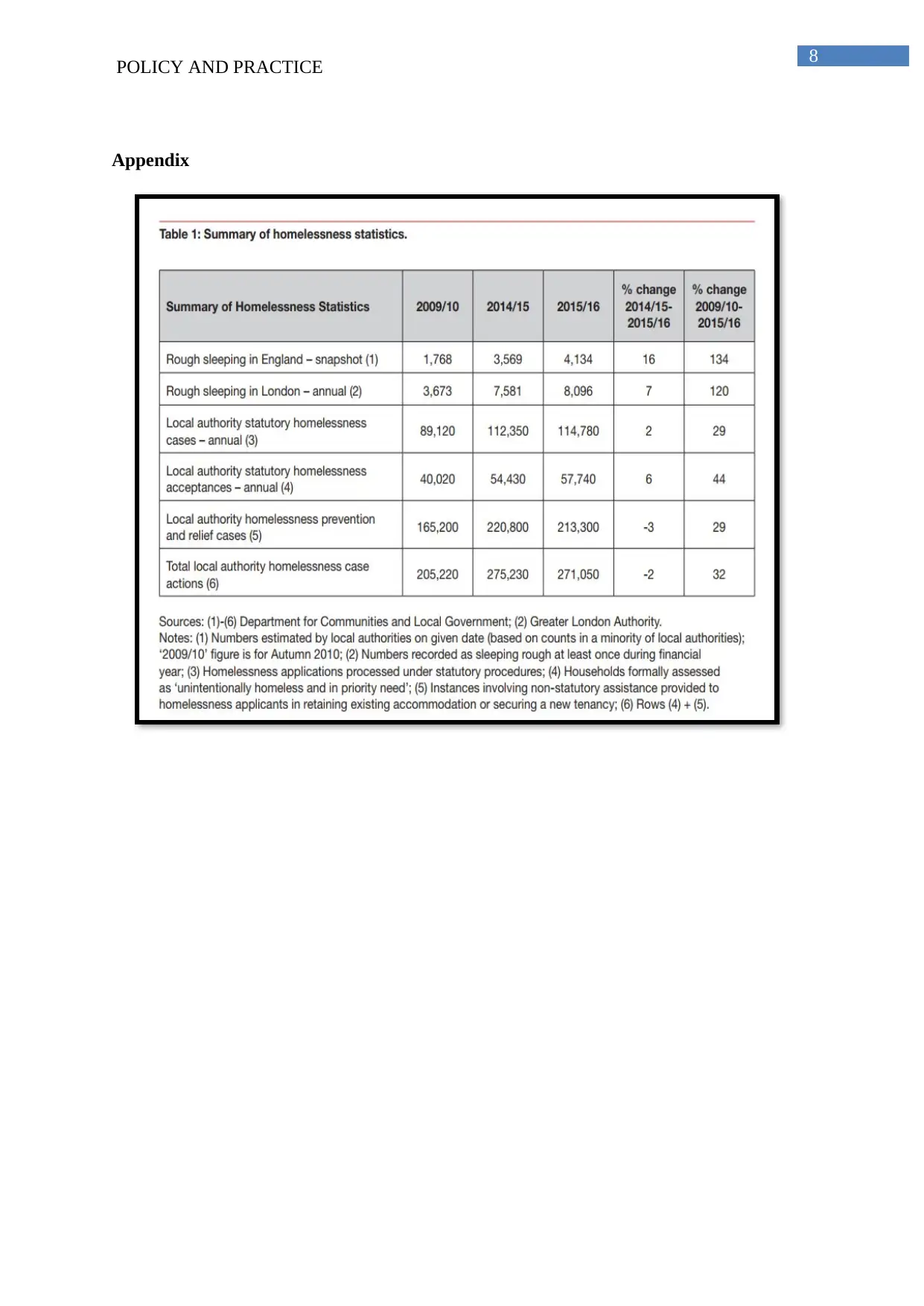
8
POLICY AND PRACTICE
Appendix
POLICY AND PRACTICE
Appendix
1 out of 9
Your All-in-One AI-Powered Toolkit for Academic Success.
+13062052269
info@desklib.com
Available 24*7 on WhatsApp / Email
![[object Object]](/_next/static/media/star-bottom.7253800d.svg)
Unlock your academic potential
© 2024 | Zucol Services PVT LTD | All rights reserved.